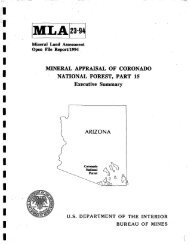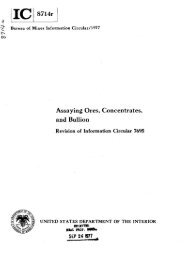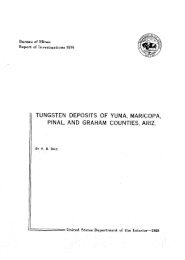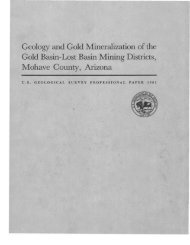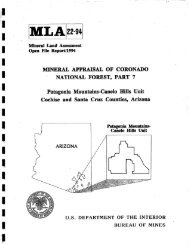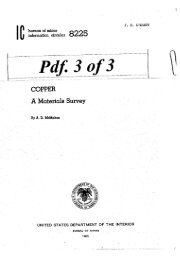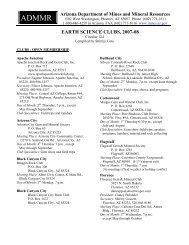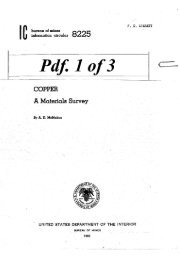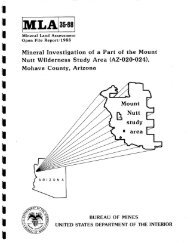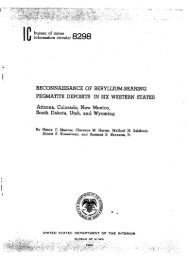here - State of Arizona Department of Mines and Mineral Resources
here - State of Arizona Department of Mines and Mineral Resources
here - State of Arizona Department of Mines and Mineral Resources
You also want an ePaper? Increase the reach of your titles
YUMPU automatically turns print PDFs into web optimized ePapers that Google loves.
in the Keystone mine probably yielded most <strong>of</strong> the<br />
gold <strong>of</strong> the district. Veins containing pyrrkotite,<br />
chalcopyrite, <strong>and</strong> gold were worked for copper,<br />
silver, <strong>and</strong> gold (Osterwald <strong>and</strong> Osterwald, 1952,<br />
p.64-66).<br />
FREMONT COUNTY<br />
The Atlantic City-South Pass district is in southern<br />
Fremont County at the southeast end <strong>of</strong> the<br />
Wind River Range, about 23 miles south <strong>of</strong> L<strong>and</strong>er.<br />
Most <strong>of</strong> the gold produced in Wyoming came from<br />
this district. The estimates <strong>of</strong> the gold output <strong>of</strong><br />
the district vary considerably. Spencer (1916, p. 27<br />
28) estimated the output to 1915 at about $1 million<br />
(72,500 ounces). Armstrong (1948, p. 37), using<br />
Spencer's figures, estimated the total gold production<br />
<strong>of</strong> the district to May 1947 at about $2 million<br />
(about 86,000 ounces), but Martin (1954, p. 1618)<br />
credited all Wyoming through 1951 with only 80,040<br />
ounces. Considering the output from other areas in<br />
Wyoming, the gold production <strong>of</strong> the Atlantic City<br />
South Pass district through 1959 probably was not<br />
more than 70,000 ounces.<br />
Though placer gold was discovered as early as<br />
1842, important mining operations did not begin<br />
until after the Cariso lode was found in 1867 (W. C.<br />
Knight, quoted by Trumbull, 1914, p. 76-82).<br />
Through 1874 the district produced about $735,000<br />
in gold (Henderson, 1916, p. 248), but production<br />
declined sharply t<strong>here</strong>after, because <strong>of</strong> the exhaustion<br />
<strong>of</strong> the rich oxidized ores near the surface.<br />
Intermittent exploration in more> recent years resulted<br />
in only minor production (Armstrong, 1948,<br />
p.35-37).<br />
The bedrock <strong>of</strong> the Atlantic City-South Pass district<br />
consists chiefly <strong>of</strong> isoclinally folded <strong>and</strong> faulted<br />
schists, gneisses, granulite, amphibolite, diorite, <strong>and</strong><br />
granodiorite, all <strong>of</strong> Precambrian age (Armstrong,<br />
1948, p. 11-34). Gold-bearing veins have been found<br />
in fault zones in all varieties <strong>of</strong> the country rock<br />
(Armstrong, 1948, p. 37-42). They occur in an en<br />
echelon pattern in zones as much as 1,000 feet long.<br />
The ore-bearing veins are mostly 2 to 6 feet wide,<br />
but they may be as much as 12 feet wide <strong>and</strong> 50 feet<br />
long. The unoxidized ore minerals consist <strong>of</strong> pyrite,<br />
arsenopyrite, <strong>and</strong> local chalcopyrite <strong>and</strong> galena<br />
(Spencer, 1916,p.28-34).<br />
SELECTED BIBLIOGRAPHY<br />
Adams, G. I., 1930, Gold deposits <strong>of</strong> Alabama <strong>and</strong> occurrences<br />
<strong>of</strong> copper, pyrite, arsenic, <strong>and</strong> tin: Alabama<br />
Geol. Survey Bull. 40, 91 p.<br />
Adams, G. I., Butts, Charles, Stephenson, L. W., <strong>and</strong> Cooke,<br />
Wythe, 1926, Geology <strong>of</strong> Alabama: Alabama Geol. Survey<br />
Spec. Rept. 14, 312 p.<br />
WYOMING 263<br />
Allen, A. W., ed., 1931, Gold mining <strong>and</strong> milling at Lead,<br />
South Dakota, 1876-1931: Eng. Mining Jour., v. 132,<br />
no. 7, p. 287-342.<br />
Allen, R. C., 1912, Gold in Michigan, in <strong>Mineral</strong> reSC'llrces<br />
<strong>of</strong> Michigan: Michigan Geol. <strong>and</strong> BioI. Survey Pflb. 8,<br />
Geol. Ser. 6, p. 355-366.<br />
Allen, R. M., Jr., 1951, Structural control <strong>of</strong> some golil-base<br />
metal veins in eastern Grant County, Oregon: Econ.<br />
Geology, v. 46, no. 4, p. 398-403.<br />
Allsman, P. T., 1940, Reconnaissance <strong>of</strong> gold-mining districts<br />
in the Black Hills, South Dakota: U.S. Bur. <strong>Mines</strong> Bull.<br />
427,146 p.<br />
Anderson, A. L., 1934, Geology <strong>of</strong> the Pearl-Horseshoe Bend<br />
gold belt, Idaho: Idaho Bur. <strong>Mines</strong> anQ Geology Pl'mph.<br />
41,36 p.<br />
-- 1943, Geology <strong>of</strong> the gOld-bearing lodes <strong>of</strong> the Pocky<br />
Bar district, Elmore County, Idaho: Idaho Bur. <strong>Mines</strong><br />
<strong>and</strong> Geology Pamph. 65, 39 p.<br />
-- 1947, Geology <strong>and</strong> ore deposits <strong>of</strong> Boise PC\sin,<br />
Idaho: U.S. Geol. Survey Bull. 944-C, p. 119-31f.<br />
-- 1949, Silver-gold deposits <strong>of</strong> the Yankee Fork district,<br />
Custer County, Idaho: Idaho Bur. <strong>Mines</strong> <strong>and</strong><br />
Geology Pamph. 83, 37 p.<br />
-- 1953, Gold-copper-Iead deposits <strong>of</strong> the Yellowjl\cket<br />
district, Lemhi County, Idaho: Idaho Bur. Miner <strong>and</strong><br />
Geology Pamph. 94, 41 p.<br />
-- 1956, Geology <strong>and</strong> mineral deposits <strong>of</strong> the Srlmon<br />
quadrangle, Lemhi County, Idaho: Idaho Bur. T"ines<br />
<strong>and</strong> Geology Pamph. 106, 102 p.<br />
Anderson, A. L., <strong>and</strong> Wagner, W. R, 1946, A geolfllrical<br />
reconnaissance <strong>of</strong> the Hailey gold belt (Camas dist'ict),<br />
Blaine County, Idaho: Idaho Bur. <strong>Mines</strong> <strong>and</strong> Ge...logy<br />
Pamph. 76, 26 p.<br />
Anderson, C. A., <strong>and</strong> Creasey, S. C., 1958, Geology ani ore<br />
deposits <strong>of</strong> the Jerome area, Yavapai County, Ariwna:<br />
U.S. Geol. Survey Pr<strong>of</strong>. Paper 308, 195 p.<br />
Anderson, C. A., Scholz, E. A., <strong>and</strong> Strobell, J. D., Jr., 1956,<br />
Geology <strong>and</strong> ore deposits <strong>of</strong> the Bagdad area, Ya"apai<br />
County, <strong>Arizona</strong>: U.S. Geol. Survey Pr<strong>of</strong>. Paper 278,<br />
103 p.<br />
Anderson, E. C., 1957, The metal resources <strong>of</strong> New Mexico<br />
<strong>and</strong> their economic features through 1954: New Mexico<br />
Bur. <strong>Mines</strong> <strong>and</strong> <strong>Mineral</strong> <strong>Resources</strong> Bull. 39, 183 II.<br />
Anderson, F. M., 1914, The Forty-nine mines <strong>of</strong> the Ashl<strong>and</strong><br />
region, Oregon, in Diller, J. S., <strong>Mineral</strong> reso"l'ces<br />
<strong>of</strong> southwestern Oregon: U.S. Geol. Survey Bull. 546,<br />
p.90-93.<br />
<strong>Arizona</strong> Bureau <strong>of</strong> <strong>Mines</strong>, 1938, Some <strong>Arizona</strong> ore depl')sits:<br />
<strong>Arizona</strong> Bur. <strong>Mines</strong> Bull. 145, Geol. Ser. 12, 136 II.<br />
-- 1958, Geologic map <strong>of</strong> Yavapai County, <strong>Arizona</strong>:<br />
Tucson, scale 1:375,000.<br />
Armstrong, F. C., 1948, Preliminary report on the ge-:llogy<br />
<strong>of</strong> the Atlantic City-South Pass mining district, Wyoming:<br />
U.S. Geol. Survey open-file rept., 65 p.<br />
Ashley, G. H., 1911, The gold fields <strong>of</strong> Coker Creek, Monroe<br />
County, Tennessee: Tennessee Geol. Survey, Reso"l'Ces<br />
<strong>of</strong> Tennessee, v. 1, no. 3, p. 78-107.<br />
Averill, C. V., 1931, Preliminary report on economic ge"logy<br />
<strong>of</strong> the Shasta quadrangle: California Jour. Miner <strong>and</strong><br />
Geology, v. 27, no. 1, p. 3-65.<br />
-- 1935, <strong>Mines</strong> <strong>and</strong> mineral resources <strong>of</strong> Sis1



